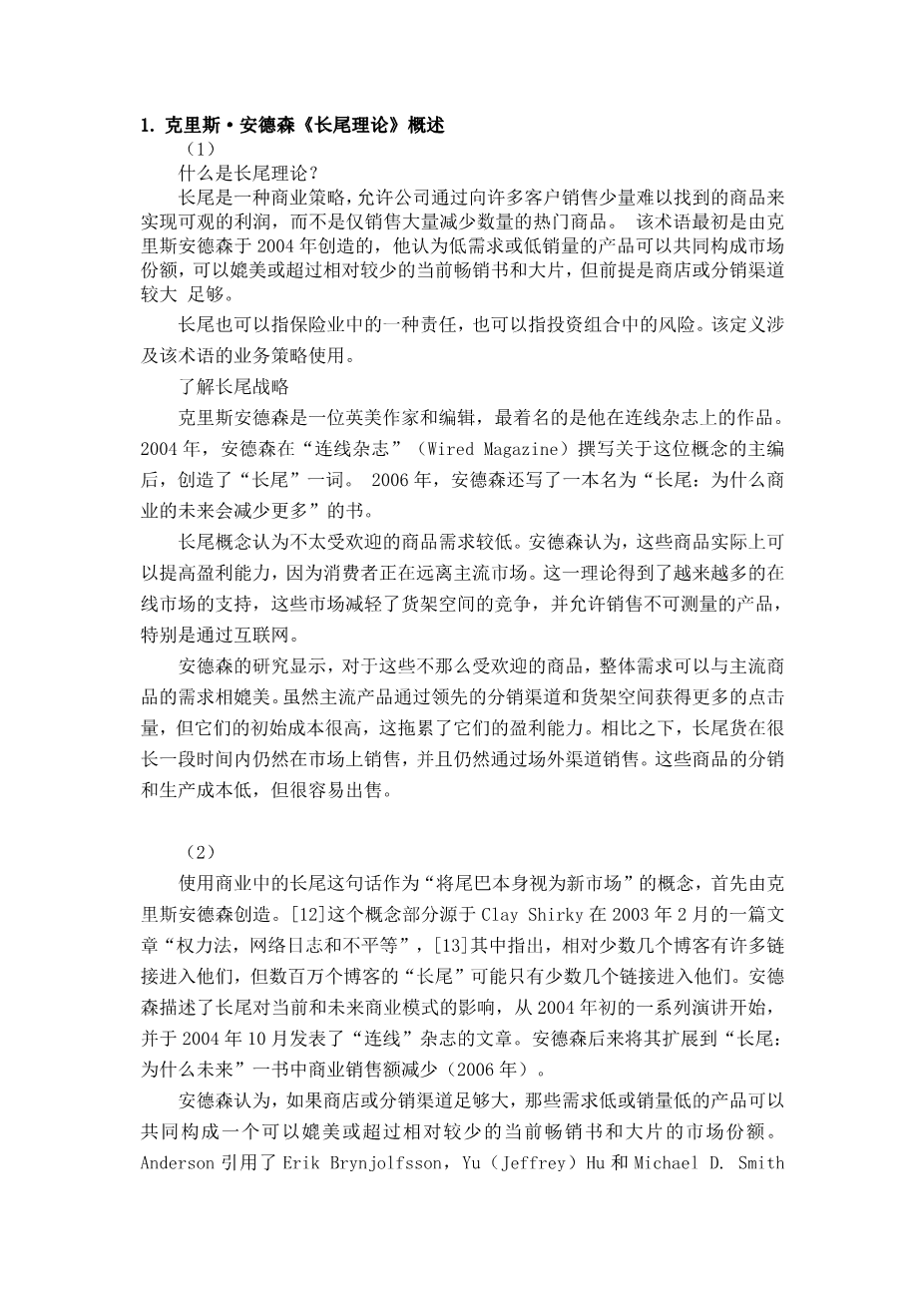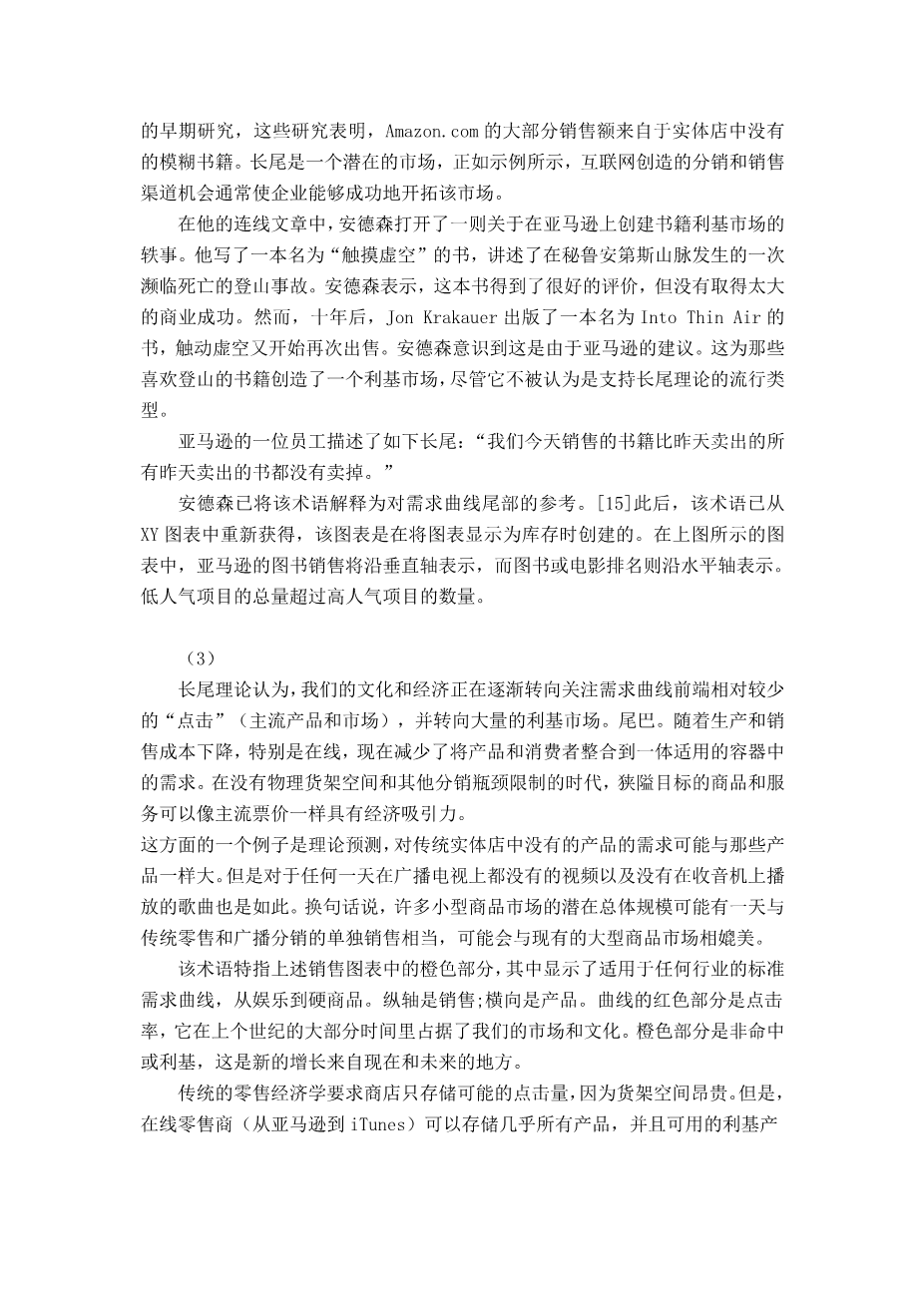

英语原文共 5 页,剩余内容已隐藏,支付完成后下载完整资料
- 克里斯·安德森《长尾理论》概述
(1)
What Is the Long Tail?
The long tail is a business strategy that allows companies to realize significant profits by selling low volumes of hard-to-find items to many customers instead of only selling large volumes of a reduced number of popular items. The term was first coined in 2004 by Chris Anderson, who argued that products in low demand or with low sales volume can collectively make up market share that rivals or exceeds the relatively few current bestsellers and blockbusters but only if the store or distribution channel is large enough.
Long-tail may also refer to a type of liability in the insurance industry or to tail risk found in investment portfolios. This definition deals with the business strategy use of the term.
Understanding the Long Tail Strategy
Chris Anderson is a British-American writer and editor most notably known for his work at Wired Magazine. In 2004, Anderson coined the phrase 'long tail' after writing about the concept in Wired Magazine where he was editor-in-chief. In 2006, Anderson also wrote a book titled “The Long Tail: Why the Future of Business Is Selling Less of More.”
The long tail concept considers less popular goods that are in lower demand. Anderson argues that these goods could actually increase in profitability because consumers are navigating away from mainstream markets. This theory is supported by the growing number of online marketplaces that alleviate the competition for shelf space and allow an unmeasurable number of products to be sold, specifically through the internet.
Anderson#39;s research shows the demand overall for these less popular goods as a comprehensive whole could rival the demand for mainstream goods. While mainstream products achieve a greater number of hits through leading distribution channels and shelf space, their initial costs are high, which drags on their profitability. In comparison, long tail goods have remained in the market over long periods of time and are still sold through off-market channels. These goods have low distribution and production costs, yet are readily available for sale.
(2)
Use of the phrase the long tail in business as 'the notion of looking at the tail itself as a new market' of consumers was first coined by Chris Anderson.[12] The concept drew in part from a February 2003 essay by Clay Shirky, 'Power Laws, Weblogs and Inequality',[13] which noted that a relative handful of weblogs have many links going into them but 'the long tail' of millions of weblogs may have only a handful of links going into them. Anderson described the effects of the long tail on current and future business models beginning with a series of speeches in early 2004 and with the publication of a Wired magazine article in October 2004. Anderson later extended it into the book The Long Tail: Why the Future of Business is Selling Less of More (2006).
Anderson argues that products in low demand or that have a low sales volume can collectively make up a market share that rivals or exceeds the relatively few current bestsellers and blockbusters, if the store or distribution channel is large enough. Anderson cites earlier research by Erik Brynjolfsson, Yu (Jeffrey) Hu, and Michael D. Smith, that showed that a significant portion of Amazon.com#39;s sales come from obscure books that are not available in brick-and-mortar stores. The long tail is a potential market and, as the examples illustrate, the distribution and sales channel opportunities created by the Internet often enable businesses to tap that market successfully.
In his Wired article Anderson opens with an anecdote about creating a niche market for books on Amazon. He writes about a book titled Touching the Void about a near-death mountain climbing accident that took place in the Peruvian Andes. Anderson states the book got good reviews, but didn#39;t have much commercial success. However, ten years later a book titled Into Thin Air by Jon Krakauer was published and Touching the Void began to sell again. Anderson realized that this was due to Amazon#39;s recommendations. This created a niche market for those who enjoy books about mountain climbing even though it is not considered a popular genre supporting the long tail theory.
An Amazon employee described the long tail as follows: 'We sold more books today that didn#39;t sell at all yesterday than we sold today of all the books that did sell yesterday.'[14]
Anderson has explained the term as a reference to the tail of a demand curve.[15] The term has since been rederived from an XY graph that is created when charting popularity to inventory. In the graph shown above, Amazon#39;s book sales would be represented along the vertical axis, while the book or movie ranks are along the horizontal axis. The total volume of low popularity items exceeds the volume of high popularity items.
(3)
The theory of the Long Tail is that our culture and economy is increasingly shifting away from a focus on a relatively small number of 'hits' (mainstream products and markets) at the head of the demand curve and toward a huge number of niches in the tail. As the costs of production and distribution fall, especially online, there is now less need to lump products and consumers into one-size-fits-all containers. In an era without the constraints of physical shelf space and other bottlenecks of distribution, narrowly-targeted goods and services can be as economically attractive as mainstream fare.
One example of this is the theory#39;s prediction that demand for products not available in traditional bricks and mortar stores is potentially as big as for those that are. But the same is true for video not available on broadcast TV on any given day, and songs not played on radio. In other words, the potential aggregate size of the many small markets in goods that don#39;t indivi
全文共13447字,剩余内容已隐藏,支付完成后下载完整资料
资料编号:[1052]


